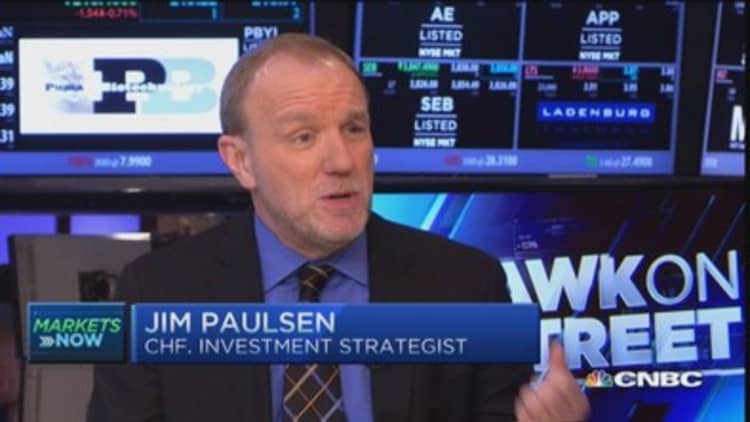
Swiss francs are up, the ruble is down, and the euro is sliding back to levels not seen in over a decade.
So what exactly, makes the value of a currency rise or fall?
The short answer: The price is set minute by minute by traders and investors who make bets on which way the market prices of a currency is headed. But there are more powerful, longer-term forces at work driving those bets.
Got a question for CNBC Explains? Send it here
A country's currency is, in part, a reflection of how well or poorly its economy is doing. And, for the moment, the U.S. is setting the pace for the rest of the world. U.S. gross domestic product surged at 5 percent annual rate from July through September (the latest reading available), the fastest pace in more than a decade. As the recovery picked up speed last year, American employers added nearly 3 million jobs to their payrolls, the biggest gain in 15 years.
Investors around the world looking for a piece of that growth have to use dollars to buy into it. And that demand for dollar-based investments drives up the price. In the second half of last year, the dollar rose more than 16 percent against a collection of world currencies.
The boom in North American oil production and the crash in the prices of oil have also helped boost the dollar value. Because oil is priced in dollars, and you can now buy more of it with the same number of dollars, it has the effect of increasing the dollar's purchasing power relative to other currencies used to buy oil.
Falling prices and rising oil production have also helped improve the U.S. trade balance, by reducing the number of dollars sent abroad to pay for imported oil and raising the export volume of refined products such as gasoline. The improved trade balance means more dollars stay at home, tightening the supply outside the U.S.
Interest Rates
Beyond investing in companies that benefit from a growing economy, global investors in many parts of the world are looking for a safe haven to park their money. The large pool of dollars available at any given time makes that easy to do. As the world's largest and most diversified economy, U.S. gross domestic product represents nearly a fifth of the total worldwide. So nearly one out of every five dollars in global economic value is created in the United States.
Investors also like the relative safety of U.S. Treasurys, which are easily traded and currently pay a higher yield than government bonds issued by other large economies, such as Japan and big European countries.
Read More Confused by currencies? Buy a Big Mac
Even though rates on Treasurys are historically low, they're still higher than the competition. The 10-year U.S. Treasury yield has fallen to 1.75 percent, less than half what it was five years ago. But the yield on Germany's 10-year recently hit just .33 percent, and an equivalent Japanese government bond recently yielded 0.22 percent. Some shorter-term German bonds are actually paying negative interest rates, which means investors end up losing a little piece of their savings just to keep them safe.
Those yields are something of a moving target, as central banks around the world continue to tinker with the supply of their local currencies. At the moment those forces are also propping up the dollar. In the U.S. the Federal Reserve is widely expected to raise short-term interest rates this year, making U.S. rates more attractive. European central bankers, meanwhile, recently announced they're going to flood the financial system with euros, driving down rates and further reducing their value against the dollar.
Weakness aborad

Currency exchange rates are a two-way street, and the dollar's strength is measured in relative terms. So while good news at home helps explain part of the gain, troubles abroad have reduced the relative value of currencies overseas.
In Japan, for example, the yen has been sliding since last summer as that country slid into recession quarter after the government imposed a sales tax increase. Having survived a snap re-election, Prime Minister Shinzo Abe has promised to jump-start growth with a series of long-awaited reforms. And the Bank of Japan continues to try to pump up growth by buying bonds to lower rates, boost inflation and drive down the value of the yen to aid Japanese exporters.
Europe's economy is also slowing, and inflation is slowing—two reasons central bankers there recently voted to pump more cash into the economy. European investors are also worried that a newly elected Greek government—ushered into office on a pledge to renegotiate crushing debt burden—could revive a debt crisis that shook the euro zone in 2012.
As the global economy has weakened, emerging markets such as Brazil are getting hit hard. Since mid-2014, the dollar has surged nearly 20 percent against the Brazilian real as the local economy is coping with slow growth and high inflation. Brazil's central bank is considering raising rates to try to fight inflation, but that could further slow growth.
Russia has been among biggest currency losers, thanks to the crash in the price of oil and a series of economic sanctions imposed by the U.S. and Europe to punish Moscow for its involvement in Ukraine's civil war. Since the middle of last year, when oil prices began falling, the dollar has nearly doubled in value against the Russian ruble. As the Russian economy slides toward recession, inflation is rising and money has fled the country. Russian central bankers have sharply raised interest rates to try to stop the bleeding, but they have dwindling foreign reserves to fight the rubles slide.


